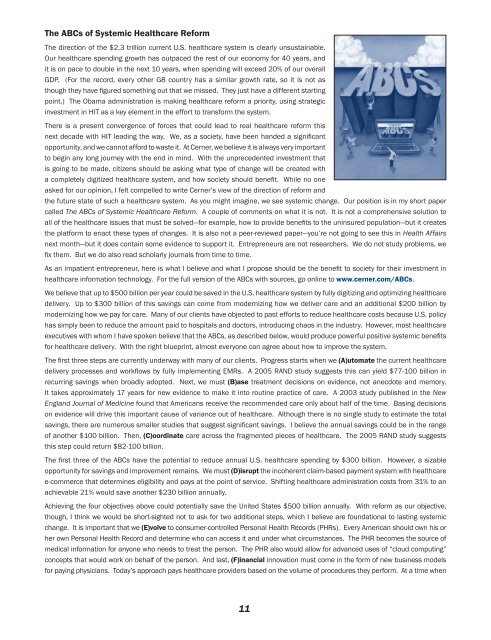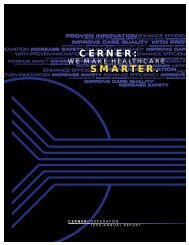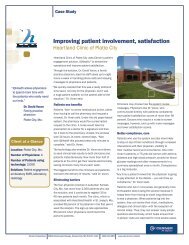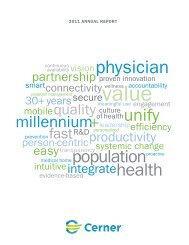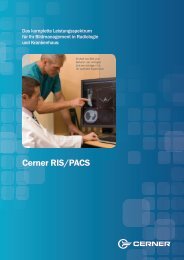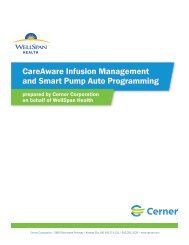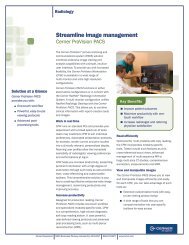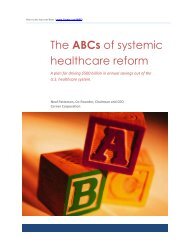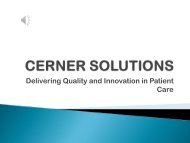The ABCs of systemic healthcare reform - Cerner Corporation
The ABCs of systemic healthcare reform - Cerner Corporation
The ABCs of systemic healthcare reform - Cerner Corporation
- No tags were found...
Create successful ePaper yourself
Turn your PDF publications into a flip-book with our unique Google optimized e-Paper software.
<strong>The</strong> <strong>ABCs</strong> <strong>of</strong> Systemic Healthcare Reform<br />
<strong>The</strong> direction <strong>of</strong> the $2.3 trillion current U.S. <strong>healthcare</strong> system is clearly unsustainable.<br />
Our <strong>healthcare</strong> spending growth has outpaced the rest <strong>of</strong> our economy for 40 years, and<br />
it is on pace to double in the next 10 years, when spending will exceed 20% <strong>of</strong> our overall<br />
GDP. (For the record, every other G8 country has a similar growth rate, so it is not as<br />
though they have figured something out that we missed. <strong>The</strong>y just have a different starting<br />
point.) <strong>The</strong> Obama administration is making <strong>healthcare</strong> <strong>reform</strong> a priority, using strategic<br />
investment in HIT as a key element in the effort to transform the system.<br />
<strong>The</strong>re is a present convergence <strong>of</strong> forces that could lead to real <strong>healthcare</strong> <strong>reform</strong> this<br />
next decade with HIT leading the way. We, as a society, have been handed a significant<br />
opportunity, and we cannot afford to waste it. At <strong>Cerner</strong>, we believe it is always very important<br />
to begin any long journey with the end in mind. With the unprecedented investment that<br />
is going to be made, citizens should be asking what type <strong>of</strong> change will be created with<br />
a completely digitized <strong>healthcare</strong> system, and how society should benefit. While no one<br />
asked for our opinion, I felt compelled to write <strong>Cerner</strong>’s view <strong>of</strong> the direction <strong>of</strong> <strong>reform</strong> and<br />
the future state <strong>of</strong> such a <strong>healthcare</strong> system. As you might imagine, we see <strong>systemic</strong> change. Our position is in my short paper<br />
called <strong>The</strong> <strong>ABCs</strong> <strong>of</strong> Systemic Healthcare Reform. A couple <strong>of</strong> comments on what it is not. It is not a comprehensive solution to<br />
all <strong>of</strong> the <strong>healthcare</strong> issues that must be solved—for example, how to provide benefits to the uninsured population—but it creates<br />
the platform to enact these types <strong>of</strong> changes. It is also not a peer-reviewed paper—you’re not going to see this in Health Affairs<br />
next month—but it does contain some evidence to support it. Entrepreneurs are not researchers. We do not study problems, we<br />
fix them. But we do also read scholarly journals from time to time.<br />
As an impatient entrepreneur, here is what I believe and what I propose should be the benefit to society for their investment in<br />
<strong>healthcare</strong> information technology. For the full version <strong>of</strong> the <strong>ABCs</strong> with sources, go online to www.cerner.com/<strong>ABCs</strong>.<br />
We believe that up to $500 billion per year could be saved in the U.S. <strong>healthcare</strong> system by fully digitizing and optimizing <strong>healthcare</strong><br />
delivery. Up to $300 billion <strong>of</strong> this savings can come from modernizing how we deliver care and an additional $200 billion by<br />
modernizing how we pay for care. Many <strong>of</strong> our clients have objected to past efforts to reduce <strong>healthcare</strong> costs because U.S. policy<br />
has simply been to reduce the amount paid to hospitals and doctors, introducing chaos in the industry. However, most <strong>healthcare</strong><br />
executives with whom I have spoken believe that the <strong>ABCs</strong>, as described below, would produce powerful positive <strong>systemic</strong> benefits<br />
for <strong>healthcare</strong> delivery. With the right blueprint, almost everyone can agree about how to improve the system.<br />
<strong>The</strong> first three steps are currently underway with many <strong>of</strong> our clients. Progress starts when we (A)utomate the current <strong>healthcare</strong><br />
delivery processes and workflows by fully implementing EMRs. A 2005 RAND study suggests this can yield $77-100 billion in<br />
recurring savings when broadly adopted. Next, we must (B)ase treatment decisions on evidence, not anecdote and memory.<br />
It takes approximately 17 years for new evidence to make it into routine practice <strong>of</strong> care. A 2003 study published in the New<br />
England Journal <strong>of</strong> Medicine found that Americans receive the recommended care only about half <strong>of</strong> the time. Basing decisions<br />
on evidence will drive this important cause <strong>of</strong> variance out <strong>of</strong> <strong>healthcare</strong>. Although there is no single study to estimate the total<br />
savings, there are numerous smaller studies that suggest significant savings. I believe the annual savings could be in the range<br />
<strong>of</strong> another $100 billion. <strong>The</strong>n, (C)oordinate care across the fragmented pieces <strong>of</strong> <strong>healthcare</strong>. <strong>The</strong> 2005 RAND study suggests<br />
this step could return $82-100 billion.<br />
<strong>The</strong> first three <strong>of</strong> the <strong>ABCs</strong> have the potential to reduce annual U.S. <strong>healthcare</strong> spending by $300 billion. However, a sizable<br />
opportunity for savings and improvement remains. We must (D)isrupt the incoherent claim-based payment system with <strong>healthcare</strong><br />
e-commerce that determines eligibility and pays at the point <strong>of</strong> service. Shifting <strong>healthcare</strong> administration costs from 31% to an<br />
achievable 21% would save another $230 billion annually.<br />
Achieving the four objectives above could potentially save the United States $500 billion annually. With <strong>reform</strong> as our objective,<br />
though, I think we would be short-sighted not to ask for two additional steps, which I believe are foundational to lasting <strong>systemic</strong><br />
change. It is important that we (E)volve to consumer-controlled Personal Health Records (PHRs). Every American should own his or<br />
her own Personal Health Record and determine who can access it and under what circumstances. <strong>The</strong> PHR becomes the source <strong>of</strong><br />
medical information for anyone who needs to treat the person. <strong>The</strong> PHR also would allow for advanced uses <strong>of</strong> “cloud computing”<br />
concepts that would work on behalf <strong>of</strong> the person. And last, (F)inancial innovation must come in the form <strong>of</strong> new business models<br />
for paying physicians. Today’s approach pays <strong>healthcare</strong> providers based on the volume <strong>of</strong> procedures they perform. At a time when<br />
11


